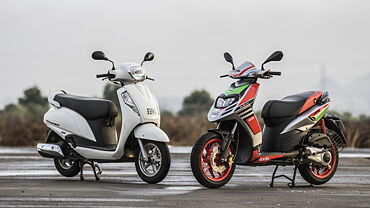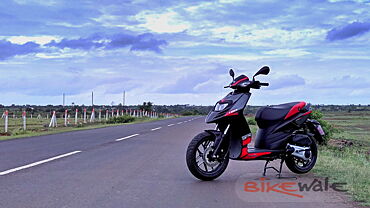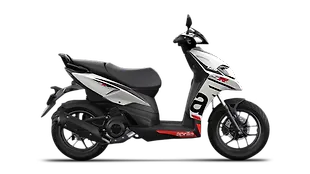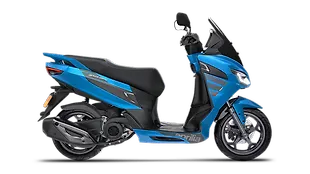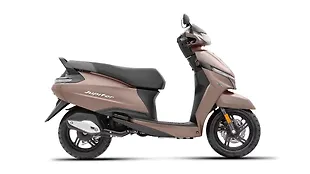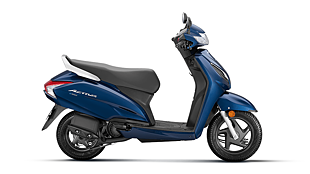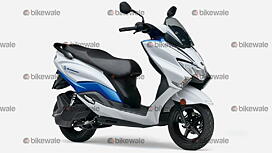Introduction

You’re in the market for a scooter, but you want to stand out. You don’t need the over-the-top (under-the-seat?) utility of the true scooter, and neither do you need the fuel efficiency of the commuter motorcycle. Oh, and you don’t want to give up on performance. Well, just like Honda offers the Activa-i and Activa 3G for the two sexes, the Piaggio group can satisfy all your premium scooter fantasies, whether they’re the feminine or masculine kind. Meet the Vespa VXL 150 70th Anniversary Edition and the Aprilia SR150.
Looks

Looking at the two together makes one wonder how the same parent company can come up with such different concepts that clothe identical drivelines. The Aprilia is masculine, with a firm foot in the here and now; all sharp edges and large wheels. The Vespa opts for a neo-retro look: high-quality paint and great-looking finishes coupled with a design that wouldn’t be out of place in the original batch of Vespas. They really missed a trick with the tyres, though – for the price, a set of whitewall tyres would have gone down a storm with the target audience. The seating position also reflects the attitude of the scooter – the Aprilia has a forward-sloping footboard that puts your toes against the front, helping you brace yourself when you brake. The Vespa chooses the traditional layout with the footboard ‘recesses’ for the feet, despite it being a monocoque chassis and therefore not needing the raised central bit that was originally made for the underbone chassis.

Instrumentation, Riding position

Quality on the Vespa has improved a lot since it initially launched in our market, but it isn’t as far ahead as its price might suggest. The Aprilia feels quite ordinary when it comes to touch and feel, but we’ll forgive it that, considering its price point. The Vespa’s chrome is really attractive, especially the bits like the front suspension. The Vespa appeals via the lovely shade of blue; the Aprilia, thanks to the snazzy graphics that adorn it and the two-tone seat.

The Aprilia’s instrument cluster is bare basic, and has a fuel gauge, speedo, odometer, a turn indicator, high beam indicator and a pass light switch. The Vespa, on the other hand, shows all of these (the fuel gauge is a digital one, as is the odometer) and there’s a low fuel warning lamp and a trip meter, but no pass light switch. There is a back rest on the 70th Anniversary Edition; there are grab rails on the SR 150. The rear seat of both vehicles isn’t very large, and the Vespa now offers pillion footpegs that fold out. We do so love the way the Aprilia’s footpegs fold up and away into the bodywork, though.
Performance

The Aprilia is heavier than the Vespa (122kg vs 114kg) and has the lower power and torque outputs of the two (10bhp/11Nm vs 11.4bhp/11.5Nm). However, pit the two against each other and it – and there’s no other way to describe this – runs off like the Vespa was drugged. Both have the exact same engine, a 150cc three-valve, carbureted unit, but Aprilia has tuned the CVT gearbox so that the Aprilia is one of the fastest scooters in the market. The brakes of both exhibit the same characteristics – great bite and progression on the front, and spongy lifelessness at the rear. There aren’t any linked brakes or ABS to help, either. The handling of both scooters is markedly different, however – the Vepsa employs a monocoque chassis and a single-sided front shock with anti-dive properties at the front, while everything about the Aprilia is conventional: regular chassis, regular front forks. The Aprilia is the one you’d want for spirited riding, because of the large wheels, grippytyres and the predictable feedback from the suspension, especially at the front. However, the suspension is set so stiff that it tends to skip about on bumpy roads, and that’s a downer for confidence. The Vespa might be the slower to accelerate and brake, but it soaks up bumps really well, meaning progress on all kinds of surfaces except for perfect ones is less stressful than on the Aprilia.

To sum up: the Aprilia is quicker in a straight line despite being down on power and torque, and higher on weight. But the Vespa is softer and quicker on everything except a perfect surface.
Verdict

If we were to judge this on price alone, the Aprilia would run away with it because you can have almost three SR150s for the price of two VXL 70th Anniversary Editions. The Aprilia will set you back back by nearly Rs 81,000 and the Vespa by a whopping Rs 1.1 lakh. The desirability of both brands is quite similar, too –both are Italian and depending on which way you lean, either one has a strong heritage in their field. Vespa is thought of as the premium scooter brand, whereas when you buy an Aprilia you’re always aware that you’re buying into a brand that has some of the greatest racing machinery of all time. However, the Vespa carries through on its promise of being a premium scooter with the quality and exclusivity, whereas the Aprilia doesn’t make one feel truly special. And that’s the overriding factor here, which is why it loses out by a slim margin to the Vespa.
Photography by Kapil Angane
Final Scores
Parameters | Max Points | Aprilia SR150 | Vespa VXL 70th Anniversary Edition |
Rank | 2 | 1 | |
Looks & styling | 10 | 7 | 7.5 |
Ergonomics & Quality | 10 | 5 | 6 |
Features & Tech | 10 | 3 | 4 |
Engine & Gearbox | 10 | 5 | 5 |
Performance | 10 | 7 | 6 |
Ride Quality | 10 | 3 | 6 |
Handling & Braking | 10 | 7 | 5.5 |
Fuel Efficiency | 10 | 4 | 4 |
Price & Warranty | 10 | 5 | 3 |
Desirablility | 10 | 6 | 7 |
Total | 100 | 52 | 54 |
Gallery
1/44
Aprilia SR150 Front Three-Quarter
Double Tap to Zoom











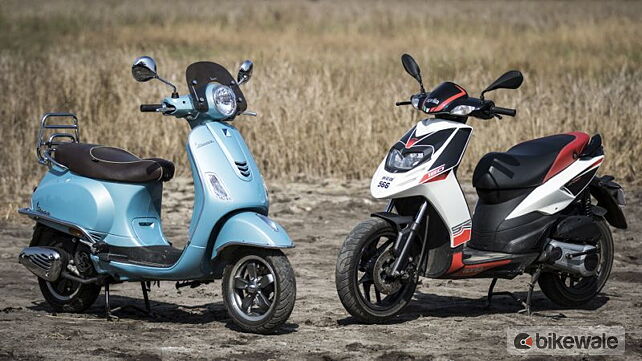












![Aprilia SR150 [2017-2018] Image Aprilia SR150 [2017-2018] Image](https://imgd.aeplcdn.com/272x153/bw/models/aprilia-sr150.jpg?20190103151915&q=80)
